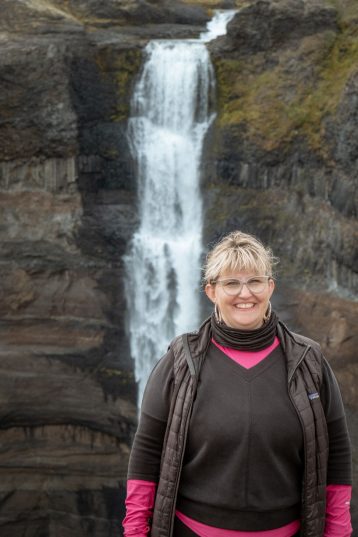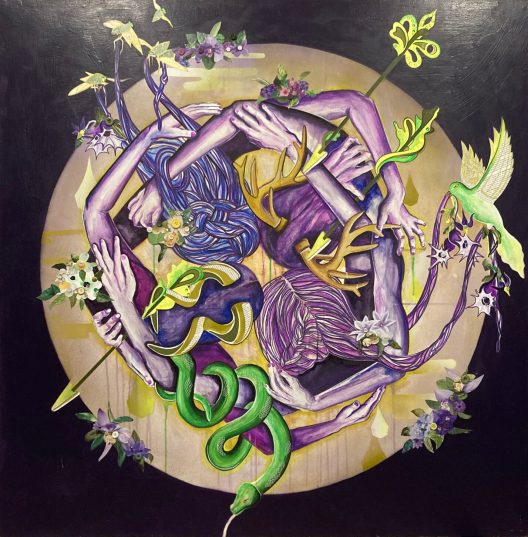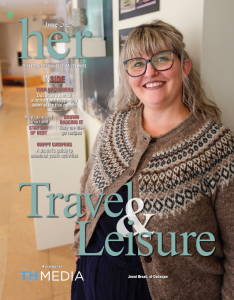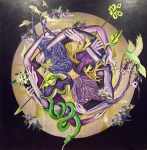I remember the smell of the kitchen at my first job. Bleach, mixed with old fryer oil, cigarette smoke and French onion soup. I started as a busser; clearing plates, filling waters, bringing out salads.
There was only one woman in the kitchen, the sous chef named Anna. She was impossibly tall, thin and had a dark brown pageboy haircut. She was quiet, barely spoke a word about her private life and never gossiped. Her presence didn’t seem strange to me, but in nearly 20 years working in restaurants, Anna was the only female sous chef I ever worked with. I’ve never worked for a woman head chef, just two line cooks and two pastry chefs.
Yet, women have historically been the cooks in any home. Cooking in private homes for many years was one of the only accepted jobs for a woman — especially if you were a Black woman. Even today, women usually are the ones who teach others to cook — yes, even that hot, award-winning chef probably talks about how he learned something from his mom or grandma — either passing down knowledge verbally, writing cookbooks or doing the job I have now, as a food writer.
Way before I ever tapped out an article, women have been writing about food, using a pen to write their way out of the home kitchen — partially so there would be opportunities for women like Anna in that country club kitchen.
Women and food? It’s complicated. Yes, we all eat, but when it comes to the bigger picture of food and what it means, we need women. Always have. Still, women frustratingly remain in the background of the food industry. Men hold the majority of the top positions and the most fame, all while using women’s stories and likenesses to sell products or bolster reputations.
Writing their way out of the kitchen and into the food industry
On Feb. 19, 1928, the front page of The Seattle Daily Times announced a new section with the headline “Department for Housewives To Be Opened by The Times.” The section would be headed by Dorothy Neighbors (a pen name for a writer named Marion Prior Olive Ferriss Guinn), a woman who — along with her department of home economists — would help Pacific Northwest housewives solve any household problem. There would be a phone line, manned by experts to answer any cooking questions, a daily radio show and a model apartment located on the third floor of The Times’ building where Neighbors and her staff would conduct business, rather than in the newsroom.
The Dorothy Neighbors section wasn’t unique — most papers around the country had begun to introduce “women’s” and “society” pages around that time. Appealing to women was another way for newspapers to make money through advertisers, and because there were so few places to get reliable information, readers were clamoring for more than just the straight news. By today’s standards, the sections were massive, ranging from 10 to 50 pages. There were society notices, recipes, horoscopes, advice columns and tips for everything from how to throw a dinner party to how to get a stain out of your husband’s shirt.
Women using a pen name weren’t unique either. Regionally, The Seattle Post-Intelligencer — and all Hearst newspapers — had a character named Prudence Penny, The Spokesman-Review in Spokane used Dorothy Dean. Farther afield, the Los Angeles Times had Marian Manners, the Minneapolis Star Tribune had Mary Hart, and the San Francisco Chronicle had Jane Friendly.
In the early 1900s, it was considered unsavory for a woman to be working as a reporter, traditionally seen as a man’s job — and somewhat unsafe because of the late hours and potential for running into misogyny or harassment from sources. Still, the pages required a woman’s byline because household affairs were squarely the domain of women, and newspapers needed to build trust with readers.
The pen name first was to disguise the true identity of the paper’s reporters but soon became a way to preserve continuity. After all, a woman only was expected to have a job (even an unsavory one) until she got married or had children, and the papers needed to keep a consistent voice.
These female journalists were accused of a lot during the years, including shilling for brands and only reporting the fluff, but in truth, they were providing a valuable resource. When the women’s pages first began, they were one of the only places to get answers. There was no internet, no cooking shows on television. Cookbooks largely were seen as a luxury. But the world was changing, already feeling smaller. Consider this: In 1939, food editor Clementine Paddleford wrote a brief in the New York Herald Tribune on how to pronounce the word “pizza.”
Paddleford and her contemporaries — Jane Nickerson at The New York Times, Mary Hammond of the Philadelphia Bulletin, Caroline Maddocks Beard and later Ruth Ellen Church at the Chicago Tribune — were guiding voices during difficult times. They reported on trends, covered the expanding idea of what “American cuisine” meant as immigrant populations grew, explained how to utilize new kitchen gadgets, and helped women stretch food and dollars during World War II.
However, they primarily were White women writing for a White audience, effectively ignoring whole populations of the U.S. Even though there were Black cookbook authors — the first being Abby Fisher and her book, “What Mrs. Fisher Knows about Old Southern Cooking,” published in 1881 — and cooks like Zephyr Wright, the personal chef for President Lyndon B. Johnson and Edna Lewis, a giant in modern Southern cooking, food editing and writing was primarily a white women’s profession.
And it remained so for another four decades, even as the profession made progress in other areas.
When Sharon Lane started at The Seattle Times in 1967, her job was listed as a reporter in “women’s news,” or the society pages. By that time, most of her colleagues were writing under their name, and Dorothy Neighbors was now known as the general section of the paper — but there were four home economists answering phones that “rang nonstop” at the office.
Someone would call asking for a recipe for meatloaf. The home economists would ask questions to narrow down available ingredients to the right recipe for the caller’s needs and if there wasn’t time to mail the recipe, read it out line by line over the phone while the caller copied it all down.
“We tried to encourage mailing at the end because it takes you a while to read out a recipe,” Lane said during a recent phone call.
For all the world’s progress people needed women to tell them how to cook.
Essential and overshadowed
By the early 1950s, cookbooks were becoming more affordable and were more specialized than the compendiums of the past. Newer specialty magazines like Gourmet and Bon Appétit were churning out content alongside stalwarts like Good Housekeeping and Better Homes and Gardens. Even before the internet, there was a ton of content in these publications. James Beard’s 1949 book “The Fireside Cook Book” had more than 1,000 recipes and it wasn’t even considered to be an anthology like “Joy of Cooking.”
But not every recipe or homemaker’s trick was a hit, and when they weren’t, there was backlash.
Newspapers, for all their reputation of fluff, had an obligation to readers. Budgets were tight, and if the paper ran a recipe for a cake that turned out to be a mess, therefore wasting ingredients and time, the editors heard about it.
“We owed the public recipes that guaranteed they could make it on Friday night and serve it on Friday night. We considered ourselves saving people a lot of money by giving them recipes that worked,” Lane said.
Even though the paper was providing an integral service, the economics of journalism changed. Budgets tightened, and having a separate section for women seemed excessive, especially as it was becoming more accepted for women to work elsewhere in the newsroom. In 1969, the service stopped answering calls on Saturdays. In 1973, Dorothy Neighbors became part of the newsroom. The name for the section was dropped in 1980, simply becoming “Food.” The recipe phone service was phased out in time, and the test kitchen later closed. Lane began running wire stories from newspapers she knew had test kitchens.
As Kimberly Wilmot Voss writes in her 2014 book, “The Food Section: Newspaper Women and the Culinary Community,” “Most newspaper food journalists have been forgotten. Like their sisters in home economics, their place in the women’s pages was a casualty of the 1970s fight for women’s equality.” This was because these women — who were serving America’s housewives — often were balancing work and their families, and relegating them to women’s pages meant they often were the target of feminist leaders like Gloria Steinem, who called for the elimination of these pages because they felt the pages marginalized women.
Instead of finding gender equality as society and women’s pages became folded into the regular newsroom, many of these women have been forgotten by history and overshadowed by their male contemporaries.
Some women, like Jane Nickerson, took extended leaves to raise children, popping up after a few years at smaller publications. Paddleford — who not only told people how to pronounce pizza but dubbed submarine sandwiches “heroes” and used to fly her plane to interviews — died in her early 60s with no heirs. Her newspaper, The New York Herald Tribune, folded in 1966, all reasons that contributed to her erasure from food media legend. Marion Manners, the pen name for Ethel Vance Morse, the food editor at the LA Times from 1931 to 1939 was named in honor of publisher Harry Chandler’s wife Marian and had no connection to either the real Marian Chandler or to Morse.
Claiborne, the editor who succeeded Nickerson at The New York Times could never have done his job without the foundation she laid and the reputation she cultivated as the first food editor at the newspaper. Beard, one of America’s most celebrated food figures, often plagiarized his female counterparts (and himself) in his 20 cookbooks and rarely gave anyone else credit for his success, despite longtime editors like Isabel Callvert and Judith Jones guiding his hand.
For Black women, the struggle continues. When Toni Tipton-Martin joined the Cleveland Plain Dealer in 1991 she became the first Black food editor at a major daily newspaper. In Vertamae Smart-Grosvenor’s 1970 memoir, “Vibration Cooking or, the Travel Notes of a Geechee Girl,” she writes “White folks act like they invented food like there is some weird mystique surround it.”
By and large, women wrote the food industry into existence, yet they continue to routinely be excluded from the most profitable and venerated aspects of the food scene.
On women and cooking
Things haven’t been any easier outside food media. Corporate brands like Betty Crocker and Aunt Jemima (created by Chris Rutt, editor for the St. Joseph News-Press in Missouri) have used women’s likeness to sell food, crafting a false mentor to guide home cooks for a century.
In professional kitchens, men consistently dominate. Out of the 365 chefs named to Food and Wine’s annual “Best New Chef” list, released every year since 1988, only about 15% have been women. According to the Bureau of Labor Statistics, in 2021, out of 402 head chefs, 22% were women. After a two year hiatus originally attributed to COVID-19, the James Beard Foundation underwent a major audit after news broke that voting in 2020 resulted in zero Black winners despite public claims of increased efforts to promote diversity. The 2022 nominations were recently announced, and seven out of the 20 semifinalists for Emerging Chef are women.
“I have never even worked for a female chef. It’s not even on purpose. There’s just not a whole lot of options,” said Monica Dimas, chef and owner of Westman’s Bagel and Coffee, during a recent phone call.
When it comes to barriers in kitchens for women, it all comes down to capital, Dimas said. As a restaurateur, she’s run into this issue personally, and after conversations with a venture capitalist who regularly funds women-led projects, she found that the number of women’s projects that get funded is abysmally small.
“It’s sad. If a woman runs a company it’s going to perform better, but money doesn’t flow to women,” Dimas said.
In addition to a lack of funding, women regularly face discrimination and harassment in the kitchen. Part of the James Beard Foundation audit was to determine how the foundation would handle mounting allegations of sexual harassment, abuse and wage theft against former winners and nominees.
Back at that first restaurant I worked in, the head chef Kevin was the source of the cigarette smoke smell. He told inappropriate jokes constantly and was known to pinch rear ends — regardless if you were his girlfriend (who also happened to be the manager) or another server.
As far as first jobs go, working in a restaurant felt like a natural one. But I’ve always wanted to be a journalist — ever since I channeled Barbara Walters in my fourth grade school picture. Professionally, I started writing about bands but always felt like a fraud. I think I remained working in restaurants for so long because it gave me a first hand knowledge, and I was pretty good at it. As I worked my way through restaurants, graduating from a busser to a server, bartender, manager and even a grill cook a few times, I always had my eye on writing about food. It was while living in Tahoe that I began writing a weekly DIY column for an online magazine, troubleshooting how to grill pizza, make crackers and pickle cherries all while working in two restaurants. It finally felt like I had something to say — something meaningful to contribute that meant more to me than an interview with a famous musician.
I spent hours in San Francisco’s used book stores, discovering M.F.K. Fischer and Ruth Reichl, eating at Alice Waters’ Berkeley restaurant Chez Panisse. Judy Rodgers, the late chef and owner of Zuni Café was a regular at one of the restaurants I worked at in Tahoe City. She’d ask questions about local produce and markets while eating Caesar salad with her fingers, one full romaine leaf at a time, like a rabbit.
While I don’t work in restaurants anymore, I love spending time in them as a diner and a food writer. Talking with people like Dimas and so many others in our city about food and a woman’s place in it. I feel as if I’m standing on the shoulders of giants, but I know there’s a long way to go. I just hope to make it better for the next person.
Jackie Varriano writes for the The Seattle Times.











